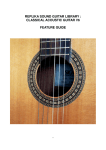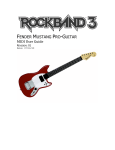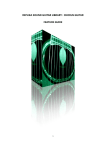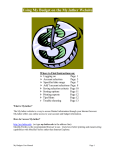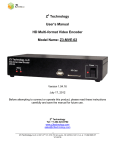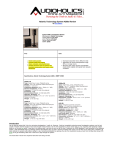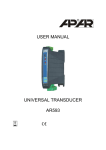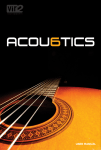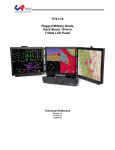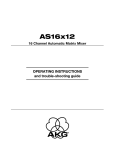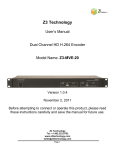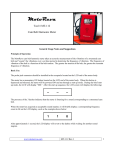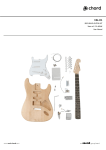Download REPLIKA SOUND GUITAR LIBRARY BASS GUITAR v5.1 FEATURE
Transcript
REPLIKA SOUND GUITAR LIBRARY BASS GUITAR v5.1 FEATURE GUIDE 1 TABLE OF CONTENTS Introduction 3 Important (Requirements) MIDI Requirements Important Note 3 3 3 Pack Contents 3 Main Interface 4 Articulation Key Switches Articulation Descriptions 5 5 Chord and Strumming Controls Chord Switches Strum Control Release Control Strum Direction Switch 6 6 6 6 6 Tremelo Function 7 Vibrato Key 7 MIDI Control 7 Contextual Help 7 Notes Use of the Slide Down Key (Key Switch F#0) 8 8 Chord List Bar Chords 9 9 Effects Units EQ Compression – Distortion - Chorus Phaser – Delay Reverb – Cabinet 10 11 12 13 14 License Agreement 15 Contact 15 2 INTRODUCTION This virtual instrument features true Random-Robin note alternation (in 5), key switched articulations, a special "Chord-mode" complete with strum speed control, direction and a choice of Bar chords or Power chords. There is also a “Tremelo Picking” feature (with speed control), a Vibrato Key to provide a quick way of playing in vibrato on any articulation and 2 pages of effects units. This instrument makes use of in-built Brightness Filters and Dynamic Envelopes which automatically respond to the velocity of each note played. These samples have been recorded directly into a mixing desk allowing the user to apply their own Virtual Amps. This library comes with two versions of the instrument (Fingered and Picked). IMPORTANT (REQUIREMENTS) Please note this instrument will NOT work on the free Kontakt 5 Player. It will time out after 10 minutes. You need to have a FULL version of Kontakt to use this instrument. MIDI REQUIREMENTS : In order to get the best out of this instrument you will need some sort of external MIDI control device. There are 3 dials and 4 switches on the player interface all of which respond to MIDI commands. You can draw this information as required in your DAW but being able to play the MIDI control information in real-time will bring out the best in this instrument. LIBRARY SIZE - The library contains 3609 samples and takes up 2.58 GB on the Hard disk. The Kontakt instrument loads 177.65 MB into the RAM for the full Fingered Bass and 175.16 MB for the full Picked Bass. There are “Lite” instruments included that use less RAM (only 108.97 MB for the Fingered Bass and 108.70 MB for the Picked Bass). PACK CONTENTS Samples - Various Articulations 5 x Kontakt 5 Instruments (2 Full Instruments Version 5.1, 2 “Lite” RAM Saving Versions and a Fret Noise Only Instrument) This User Manual 3 MAIN INTERFACE Note: All the MIDI note names used refer to C3 as middle C. This means: C3 is the MIDI note number 60. The Instrument Range is D0 to G3. 4 ARTICULATION KEY SWITCHES These are on the left of the Kontakt keyboard in Red. Legato Non Vibrato Marcato Staccato Hammer On Pull Off Slide Up into Note Slide Down after Note Fret Noise Harmonics Natural Slap - Thumb Slap - Finger SFX C-1 C#-1 D-1 D#-1 E-1 F-1 F#-1 G-1 G#-1 A-1 A#-1 B-1 (Random Robin in 5; 3 for Lite version) (Random Robin in 5; 3 for Lite version) (Random Robin in 5; 3 for Lite version) (Random Robin in 5; 3 for Lite version) (Random Robin in 5; 3 for Lite version) (1 Group) (1 Group) (1 Group) (Random Robin in 2; 1 for Lite version) (Random Robin in 3; 1 for Lite version) (Random Robin in 3; 1 for Lite version) (1 Group) ARTICULATION DESCRIPTIONS : Long sustained notes with no vibrato. Short notes. Marked attack. Longer than Staccato. Short notes with sharp attack. Note played by placing finger on the fret board. It is not plucked / picked. Note played by pulling the fretting finger away from the fret board. It is not plucked / picked. Slide-Up : Sliding up the fret board into the note. The volume of the Slide-Up sample is controlled by the velocity of the Slide-Up Key Switch i.e. Press F0 harder for louder Slide-Up samples. Slide-Down : Sliding down the fret board after the note has been played. The volume of the Slide-Down sample is controlled by the velocity of the Slide-Down Key Switch i.e. Press F#0 harder for louder Slide-Down samples. Fret Noise : Squeaks and scrapes made by the natural movement of the fretting hand around the fret board. Fast hand movements tend to make louder fret noises. Harmonics Natural : Harmonics played by placing the fretting finger at various "Nodes" on the string. Each note is not actually fretted. Chromatic harmonics are provided here (only possible on a real bass guitar with some clever technique). Slap - Thumb : Slap Bass Technique. The side of the thumb strikes the string. Sharp attack. Slap - Finger : Slap Bass Technique. Finger pulls against the string. Sharp attack – Twang. SFX : Scrapes, slides, bumps, percussive hits and other noises. Legato Non Vibrato : Marcato : Staccato : Hammer On : Pull Off : 5 CHORD AND STRUMMING CONTROLS CHORD SWITCHES : RSGL 03 features a unique Chord Mode. This is enabled by clicking on either of the chord switches (marked Bar and Power - both of which respond to MIDI commands. See "MIDI COMMANDS"). For Bar chords a section of the keyboard on the right (above the highest note of the instrument) will turn yellow to indicate the range of chords available. Each note will select a different chord, the name of which will be displayed in the chord name window, along with the notes which make up the chord you are playing. To play a chord simply click on one of the Chord Mode switches, select a chord and play its root note on the keyboard. Each note of each chord played is selected using a true Random-Robin algorithm. For example in a 4 note A Major chord played in the Legato articulation – 1 of 5 possible notes is selected for the A0 note 1 of 5 possible notes is selected for the next note (E1) 1 of 5 possible notes is selected for the next note (A1) and so on. This leads to a much more human feel as each repeated strummed chord sounds different from those around it. Bar chords are made when the bass player uses his/her index finger to act as a “bar" across the fret board. These chords are the most flexible as many common shapes work up and down the entire range of the instrument. In total there are 26 Bar chord types available on this instrument. They are listed (together with their corresponding piano keynote) in the "CHORDS LIST". Power chords are 3 note chords made up of the root note (i.e. the key you play), a Fifth above and an Octave above. They are most often used in rock music styles and suit lots of heavy distortion. STRUM CONTROL : This dial will control how fast each chord is strummed. Turn clockwise for faster strumming; anticlockwise to slow down the strum speed. RELEASE CONTROL : This dial will change the overall release of each note in the instrument. It is designed to help blend chords together when fast strumming is played / programmed. STRUM DIRECTION SWITCH : Use this switch to change the direction of strummed chords. The switch will display the current direction of strumming. 6 TREMELO FUNCTION This function allows any note in any articulation to be played in a fast picked repeated style. Each note is selected using the Random-Robin technique so each note in the tremelo picked sequence will be different thus avoiding the “machine-gun” effect. Turning the “Speed” dial (by clicking on it and dragging) will change the speed of the tremelo picking. This feature is primarily designed for Legato, Marcato or Staccato articulations but can provide some interesting sounds when applied to other articulations (like the SFX, especially when combined with the effects units available for this instrument). VIBRATO KEY It is useful to use the pitch bend wheel to simulate a player bending up a string (i.e. pitching up the string with his or her fingers). This is a common guitar technique, often used in solos. Small variations in pitch wheel position can be used to simulate vibrato. However, this instrument includes a "Vibrato Key". The note C0 on the keyboard, when pressed, will raise the pitch of a played note thereby allowing the user to "play” in vibrato (every time you press C0 the pitch will go up; every time you let go the pitch will drop back down). This can be used to punch in quick vibrato completely freely. The amount of pitch bend increases with C0 note velocity (i.e. hard key presses will result in more pitch bend). MIDI CONTROL Each dial/switch can be controlled by external MIDI controllers (in fact this is recommended as a more intuitive way of using this instrument). Here is the list of parameters and their corresponding MID channels and ranges. CONTROL Strum Speed Release Tremelo Speed Bar Chord On/Off Power Chord On/Off Strum Direction Tremelo On/Off MIDI CHANNEL 16 17 18 86 88 89 90 RANGE 0 - 127 0 - 127 0 - 127 Off <= 64. On > 64 Off <= 64. On > 64 Strum Down (Off) <= 64. Strum Upwards (On) > 64 Off <= 64. On > 64 CONTEXTUAL HELP Clicking on Kontakt’s Info button will reveal an Information Bar at the bottom of the player. Information (including MIDI CC numbers) can be displayed for each Dial/Switch on the GUI by hovering the mouse across each control. 7 NOTES USE OF THE SLIDE DOWN KEY (KEY SWITCH F#-1) - This key switch behaves differently than the others. Pressing this key switch will cut off any existing note(s) and play a sample (at the preceding note's pitch) of the note being "slid" downward in pitch. This sound is commonly heard at the end of songs or during solos where the player slides his/her hand down the fret board in between notes or to finish off a note/chord. 8 CHORD LIST BAR CHORDS : CHORD Major Minor 7th Major 7 Minor 7 Suspended 2nd Suspended 4th 6th Minor 6 6 Add 9 9th Major 9 Minor 9 11th Major 11 Minor 11 Major 13 Minor 13 Diminished Diminished 7th Half Diminished Augmented Augmented 7th 7 Sharp 9 Major minor 7th Major 7 flat 5 Key switch Note A3 A#3 B3 C4 C#4 D4 D#4 E4 F4 F#4 G4 G#4 A4 A#4 B4 C5 C#5 D5 D#5 E5 F5 F#5 G5 G#5 A5 A#5 9 EFFECTS UNITS This instrument makes use of Kontakt’s built in effects. These have been tailored and arranged specifically for the instrument. They are chained linearly in this order (i.e. one feeds into the next) :EQ - Compression - Distortion - Chorus - Phaser - Delay - Reverb - Cabinet Simply click on the left hand switch of each unit to engage the effect. A Blue LED indicates the unit is On. Use CTRL (PC) or CMD (MAC) click to reset each effect parameter back to its "zero" state. 10 They are spread over two pages. EQ : 4 Band Equalization comprised of 2 shelves and 2 bell EQs. Low Shelf EQ : Set at 160Hz. Low Mid "Bell" EQ : Set at 280Hz with a broad Q of 1.8 High Mid "Bell" EQ : Set at 800Hz with a broad Q of 1.8 High Shelf EQ : Set at 1.7KHz. All markings on the unit are in dB. Range is from -12dB to +12dB. 11 COMPRESSOR : A 4:1 ratio compressor. Threshold : -16dB to +20dB Attack : Attack time in milliseconds. Range is from 0.1ms to 30ms. Release : Release time in milliseconds. Range is from 100ms to 1600ms. Turning the dial fully clockwise (i.e. fully to the right) will set the release time to Auto (follows the musical programme). Makeup Gain : Range is from -3dB to +8dB DISTORTION : Drive : Adjusts the amount of distortion Tone : Controls the brightness of the sound Treble : Adjusts the high frequency gain Bass : Adjusts the low frequency gain Switching on the Cab effects (see below) will warm the distortion sound. CHORUS : Depth : Adjusts the range of modulated detuning. Higher values give a more pronounced chorus effect. Speed : This is the speed of the chorus LFO. Range is from 0.05Hz (slow) to 6.0 Hz (fast). Phase : Range is from 0°to 90°. This imparts a phase difference between the left and right channels. Higher values will widen the sound. 12 PHASER : Depth : Controls the amount of LFO modulation. Higher values cause the phaser effect to sweep over a wider frequency range. Speed : This is the speed of the phaser LFO. Range is from 0.05Hz (slow) to 8.0 Hz (fast). Phase : Range is from 0°to 90°. This imparts a phase difference between the left and right channels. Higher values will widen the sound. Feedback : This adjusts the emphasis of the peaks and troughs that the phaser comb filter imparts on the signal. Higher values lead to a more pronounced effect. DELAY : Level : This is the "Wet" level. Turn this up to hear the delay sound. Range is from -∞ dB to +3dB. Time : This is the delay time in milliseconds. Range is from 30ms to 1000ms (1 sec) Feedback : Range is from 3 to 90. 3 gives only one short, almost imperceptible, repeat. 90 results in a long echo tail. HF Damping : Controls the attenuation of the high frequencies of each echo. 0 results in no high frequency damping. 100 results in lots of high frequency damping (i.e. a warmer sounding echo). Width : Turning this up will result in a wider echo sound. Each echo will be panned alternatively left and then right. At 100 the result is wide left and right echoes - the classic "ping-pong" effect. 13 REVERB : This does not have an On/Off switch like the others. It is on all the time - use the level control to add how much is heard. The default setting is 0 (i.e. not heard.) This unit contains two custom designed convolution reverbs. The switch to the right will select between a 1.42 sec plate reverb and a 3.74 sec Hall reverb. Use the controls to set parameters for each reverb. Each reverb type is independent. As you switch between the two different types you will see the knobs change positions to reflect the different settings for each reverb. Level : This is the "Wet" level i.e. the volume of the reverb effect. Range is from -∞ dB to +3dB Predelay : This is the length of the short delay between the dry signal and the reverb effect in milliseconds. Range is 0.1ms to 200ms. Hi Pass : Adjusts the cutoff frequency below which the signals frequency content will be attenuated. Range is from 50Hz to 2KHz. Low Pass : Adjusts the cutoff frequency above which the signals frequency content will be attenuated. Range is from 2KHz to 20KHz. CABINET : All the above effects run through a virtual speaker cabinet as if you had really plugged a bass guitar (via a collection of stomp boxes) into an amplifier. This cabinet is loosely modelled on an Ampeg Bass Amp. Simply click the Left Hand Cabinet Switch “On” for an amped bass guitar sound. The amp can be tweaked in terms of high and low frequency shelves. 14 LICENSE AGREEMENT Replika Sound Guitar Libraries are under Royalty-Free non-exclusive license. It means that you can use the contents as part of your commercial and non-commercial music compositions for CD, DVD, Video, Movies, TV, Games, Websites, Presentations etc. without payment or any further fees. This license is personal and non-transferable. The products you have purchased are non-exclusively licensed, not sold to you. You can NOT resell entire or separate elements of these packs as your own or as part of any other sample library or software/hardware. Any unlicensed usage will be prosecuted to the maximum extent possible under the law. CONTACT For further information, news and other libraries please visit www.replikasound.co.uk © Replika Sound 2013 15
















